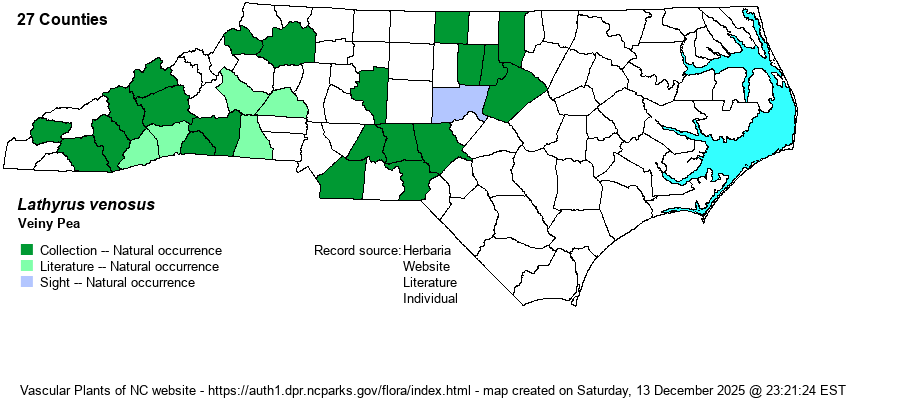| Author | Muhlenberg ex Willdenow | |
| Distribution | Scattered over essentially all of the Mountains and Piedmont, but many small holes in the range. Does not occur in the Coastal Plain.
This has an oddly disjunct range over the eastern half of the continent. It ranges from southeastern Canada to central GA and eastern TX. However, it is very rare south of the Great Lakes, west of the Appalachians, yet it is widespread in the Ozark and Ouachita Mountains. | |
| Abundance | Rare to very uncommon over the Mountains and Piedmont. In general, very uncommon in the southern half of the Mountains, and also in the eastern half of the Piedmont, but rare in the northern Mountains and most of the western Piedmont. Not certain if this abundance level dichotomy is real (rarer in the middle of the range than at either end). The NCNHP considers this as a Watch List taxon, though it lists it under var. venosus. The editors choose not to include the variety, as there is no other variety found in the state. | |
| Habitat | This species occurs in often rocky, dry or mesic soils, of woodlands, river and creek banks, bluffs, and other "uneven" ground, typically favoring higher pH soil (such as derived from mafic substrates). It can occur in bottomland forests, but more often in openings or drier places, and it is not to be considered as a wetland species. | |
| Phenology | Blooms from April to June, and fruits from July to September. | |
| Identification | This is a somewhat robust, vine-like legume, growing along the ground or draped over other vegetation, and reaching about 2-3 feet long. Its leaves are even-pinnate, with 8, 10, or 12 leaflets but with no tendrils. The leaflets are rather large, being elliptic with mostly a rounded apex (though can have a mucronate tip), about 1.5-2 inches long and about about 1/3 to 1/2 as wide. The several flower clusters grow on long stalks that are about 4 inches long, with a very dense raceme of from 10-30 flowers; each flower is lavender-purple and about 1/2-inch long. Observers should have little trouble identifying this species, as it has a somewhat "woody-looking" stem and roughly 10 leaflets; very few legumes have even-pinnate leaflets in the 8-12 leaflet range. The dense "Wisteria"-like raceme of purplish flowers seems to be infrequently seen, but when you see it, the plant cannot be overlooked or mistaken. It has such a wide array of habitats that it can and will be hard to intentionally look for it, unless you already know where it occurs. But, it does show favoritism for somewhat high pH soils. | |
| Taxonomic Comments | None
| |
| Other Common Name(s) | Forest Pea, Veiny Vetchling, Bush Pea | |
| State Rank | S3 | |
| Global Rank | G5 | |
| State Status | W1 | |
| US Status | | |
| USACE-agcp | FAC link |
| USACE-emp | FACW link |

